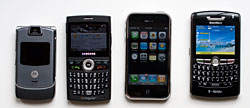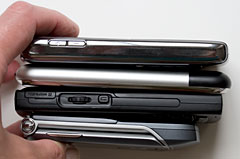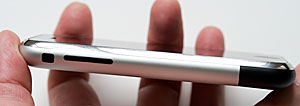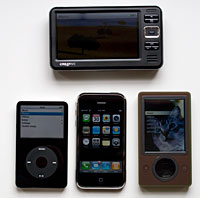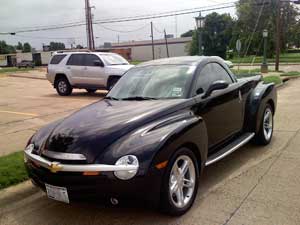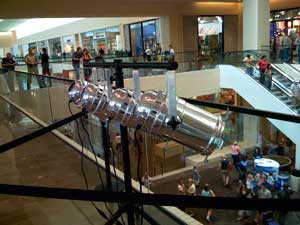
|
||||||||||||
Phone and Reception AT&T has a 5 year exclusive on the iPhone in the US. While their coverage is generally very strong and broad, only you know if their service is available and adequate in your area. The iPhone is a quad band GSM world phone supporting the 850/900/1800/1900MHz bands, and it will work anywhere in the world GSM service is available. The phone is sold locked to AT&T however, which means you can't pop another GSM carrier's SIM in the phone. The SIM card is located at the top edge of the phone, and you must stick a paper clip in the tiny hole to eject the SIM card tray. You can use the SIM in other AT&T phones and both voice and data will work (it will use MEdiaNet and the WAP.CINGULAR APN). But you'll have to use normal voice mail rather than the iPhone's visual voice mail while that SIM is in another phone. There is no voice dialing, period. Will that come later? Our crystal ball declines to answer. But there is something unique to the iPhone: Visual Voicemail. Tap on the voicemail button and you'll see an email style list of new voicemail messages, complete with the caller's name if they're in your address book. This means you can quickly select among voicemails to listen to important messages first. Our iPhone's voice quality was good and volume was average. We've seen some reports in other reviews of problems with these, but we absolutely had no problems with either. Voice isn't as crystal clear as on 3G AT&T phones like the BlackJack and 8525 which use a higher quality voice codec (thanks to the greater bandwidth on 3G) but we heard no discernable difference in voice quality or volume when switching between our BlackBerry Curve, 8800 and iPhone. Likewise, call quality and volume are fine through the included stereo headset which plays voice in two channels of mono. Should a call come in while you're listening to music through the headset, the music fades and you can pinch the inline mic to pause to take the call (on-screen answer or reject with caller ID info appear on screen as well). Reception has been excellent on our unit.
The SIM card tray is located on the phone's upper edge. Push a paper clip into the tiny hole (it takes some force) to eject the tray and SIM card. Web, email and Networking Unfortunately, the iPhone doesn't have 3G, which is a shame given the fantastic Safari web browser that provides a true desktop view of web pages. Instead, the iPhone has EDGE (also referred to as 2.5G) which averages 90 - 150k. The bright spot is WiFi: the iPhone has 802.11b/g for much faster web browsing and email downloads. Of course you need to be in range of a home, work or public hotspot to use WiFi, unlike EDGE which is available anywhere you can get a GSM signal. The iPhone prompts you to connect to WiFi networks it finds when you launch the web browser. You can turn this off if it bugs you, and you can turn WiFi off when not needed. When setting up a WiFi network connection, the WEP password entry defaults to Apple friendly style and not HEX/ASCII. Unless you use an Apple Airport, be sure to change this option when entering the WEP key for a WiFi access point. Safari looks just as good in real life as it does in Apple's demos. Of course, pages won't load as fast as their demos unless you use WiFi. It looks just like Safari on the desktop and it supports QuickTime, but not Java or Flash (we hope that comes soon, the web without Flash isn't quite the same). No surprise that it doesn't support Windows Media Player videos either. To scroll a page, simply drag your finger in the desired direction. To zoom, double-tap on the area of the web page you wish to view. Double-tap again to zoom out. Since you must use your finger and not a fingernail or stylus, selecting hyperlinks takes some patience (they're small targets for fleshy fingertips). Safari supports multiple windows, SSL, Javascript, CSS, frames tables, dHTML and pretty much everything else Safari on the desktop handles. The email client is slick and pretty. It looks much like the Mac OS X mail program and even uses Mail's sounds. The iPhone supports an unlimited number of POP3 and IMAP accounts along with Gmail (as POP3), Yahoo push, AOL mail and .Mac mail. Jobs indicated that full Exchange support is in testing now and will follow, though you can currently setup an Exchange account if the mail server is set to use IMAP. Visto has announced that they'll offer an Exchange solution for the iPhone in Q3 of 2007 and will offer a 60 day trial-- we're not sure if this is what Jobs was referring to or if Visto's will be an alternate solution). Other than Yahoo's push email, the iPhone does not currently support push email. It can however check on a schedule (i.e.: every 15 minutes, every 30 minutes) or manually. This is a rich HTML email client-- if you get a fancy formatted HTML newsletter, it looks the same as it would in your desktop email client. It supports attachments and supported file types include text, Word, Excel, images and PDF (.c, .cpp, .diff, .doc, .docx, .h, .hpp, .htm, .html, .m, .mm, .patch, .pdf, .txt, .xls, .xlsx). Though the iPhone does not come with an Office suite, it can display Word and Excel files in-line in the body of the message, but not PowerPoint. There's no editing and no saving of documents by themselves. Our test Word and Excel files looked like the originals with formatting and colors preserved, though our Excel chart didn't render. We hope Apple ports a version of their iWork (Office compatible apps) soon.
The Safari web browser viewing our home page. Display and Getting Touchy The iPhone has a very high resolution display by phone and iPod standards: 480 x 320 pixels at 160 dpi. That means video looks great, text is super-sharp and you can see quite a bit of a web page using Apple's excellent Safari web browser built into the phone. The display isn't just for looking it: it's a touch screen, and not the garden variety PDA touch screen but rather one that's gesture-aware and multi-touch aware. Just about everything is accomplished using fingers on the sturdy glass: selecting applications, dialing phone numbers, scrolling through emails and moving through music and video selections. It's very easy to use and we got the hang of it immediately. Swipe your finger up to scroll, pinch two fingers outward to zoom a photo and pinch inward to zoom out. Lists have a mini-alphabet on the right so you can move quickly through long lists. Turn the iPhone to landscape orientation and the display automatically rotates to landscape when in an application that supports it such as iPod, Safari, YouTube and Photos. It can rotate in either direction for landscape mode, making it leftie friendly and rotation is near-instant. Wow. The screen turns off when the phone is next to your face (this only happens in the phone app). A proximity sensor handles this-- very sci-fi! That way you don't accidentally press an on-screen button. In the three days we've had the phone, it hasn't suffered a scratch when in pocket or purse. The phone goes to sleep automatically and wakes up when you press the power or Home button. You'll then swipe your finger to right to unlock the phone. The phone sleep/lock duration is adjustable, as is display brightness, though we found the auto brightness setting worked well.
Since there's no hardware keypad or number pad, you'll tap on the glass to enter numbers on the large on-screen dial pad, and likewise on the on-screen keyboard when you need to enter text. Dialing is easy, though with no tactile feedback, we don't recommend doing this while driving (the iPhone makes a key-click sound but it's quiet enough to miss in a moving car). Note that there is no voice dialing and no smart dial (enter a few letters to bring up a list of matching contacts) but there is a speed dial list, or favorites. The iPhone is best used with full attention when it comes to phone use: not when driving, jogging or running to catch a plane. The keyboard works best when we kept typing without worrying about mistakes. The auto-correct feature works quite well. It definitely will take a few days practice to get good at one-fingered typing. In one day we've gotten quite fast at that, but not at two-thumb typing. We'll update the review to indicate our progress. At the moment, I wouldn't say it competes with the Treo 750 and BlackBerry Curve, but who knows what can happen with a few days practice? Applications and Syncing The iPhone syncs to Macs and PCs using iTunes. On the Mac you can sync calendar and contacts (Mail, Entourage and iCal are supported), email (just account settings or mail too), and of course your iTunes music and video library. The iPhone can sync playlists or selected songs/videos using the "only sync checked items" method. Windows users can sync to Outlook, Outlook Express and Vista's new mail program for calendars, contacts and email info. Syncing 214 songs (1 gig's worth) took 3 minutes over the USB 2.0 connection. The iPhone charges while connected to the sync cable. ITunes automatically backs up the iPhone when it syncs (we didn't know it was happening, it was so fast).
Top: Creative Zen Vision W. Bottom: iPod Video, iPhone and Zune. Unlike the iPod, the iPhone does not support hard disk mode. This means you can't mount it like a portable hard drive and use it to transfer files between home and office, nor can you copy Office files or PDFs. But multimedia file transfer support via iTunes is excellent. It's easy to move photos to and from the iPhone and both tunes and video transfer as simply as they do with an iPod. The iPhone comes with YouTube and this plays the approximately 10,000 videos that YouTube has converted to H.264 format. YouTube will continue to convert files to this format, so the selection will grow. Videos look better on the iPhone than they do in their Flash iteration on the desktop, and the player has a variety of options including bookmarking. YouTube is watchable over EDGE but it's really best for WiFi use. Google Maps has been completely iPhone-ized to support finger scrolling, pinch-zooming and tapping. There isn't enough space here to describe all it can do: watch one of the demos on Apple's web site. There are map and satellite views, list view, POIs, directions, traffic and more. Satellite imagery looks great, and loads quickly even over EDGE. We quickly found our location on the map, saved it as a favorite then typed in "movie theater" plus our zip code to see a map with pinpoint markings of all the theaters in our area. Tap on it to see the address and double-tap to get more info about that theater including a web page with show times (if the theater has one). Apple includes two Widgets: one that tracks stocks via Yahoo (you can add and remove stocks) and weather (you can have several cities tracked, and flip between them with a finger). These work quickly over EDGE. The clock is a world clock (again, you can track several cities), alarm clock, timer and stopwatch. There's also a basic calculator, a capable threaded SMS app that integrates with the address book and a photo viewer that can handle JPEG, GIF, BMP and TIFF files. The contacts application has every field one would ever need, including a caller ID photo and you can dial from the address book. You can set favorites (a speed dial list) and this is accessible from the phone screen, as is contact, call history, a voicemail shortcut and the keypad. The calendar has list, month and year views but no week view (odd). It supports repeating events, multi-day events and more. The Notes application is a text-based notepad and you can save and email notes but not sync them. Two things take getting used to: application settings aren't accessible inside the application. You'll need to go to the Settings icon on the Home screen and scroll through the list of applications to get to their settings. The good part is complete standardization of the interface: you never have to wonder where an application has hidden that setting you were looking for. The drawback is you must leave the application to change its settings. The other odd thing is that there is no exit application function. Granted Windows Mobile doesn't have this either, but Windows Mobile devices have a habit of becoming unstable due to memory management issues as a result. Palm OS doesn't have this because Palm OS doesn't support multi-tasking. Nokia S60 apps do have both close (minimize in Windows Mobile lingo) and exit options. Given that most of the competition doesn't give you an exit option, what's the worry? So far none since the phone has been stable, even with every app launched repeatedly over several days. You can force quit a misbehaving application by pressing the sleep/power button for more than 6 seconds.
Battery Life The iPhone has a Lithium Ion battery that's not user replaceable as we mentioned. Shame on you Apple. After 300 to 400 full charges, you'll have to send it to Apple for an $86 (including shipping) battery replacement that takes 3 business days. The only saving grace is the iPhone has phenomenal battery life, and unlike many Windows Mobile and even some S60 Nokia smartphones, it doesn't require daily charging with moderate to even heavy use. We don't know how Apple has done this: a large bright display, powerful CPU and lots of flash memory should eat lots of power. Even WiFi lasts way beyond the 2 to 3 hours we get with most PDA phones. And it plays video twice as long as my iPod Video 5G: just a bit above 6 hours in our tests so far. Music playback is close to the claimed 24 hours and an hour long phone call dropped the battery about 11% (Bluetooth and WiFi were on). The iPhone has flight mode, so you can use it as a multimedia player on a plane, and you can turn Bluetooth and WiFi on/off to conserve battery power if needed. Though Bluetooth had no impact on battery life in our tests. Bluetooth Not many profiles here: handsfree and headset. No A2DP (that's not in regular Mac OS X Tiger either, *sigh*), no file transfer, no HID for Bluetooth keyboards. The iPhone doesn't beg for file transfer because it's so easy to get content onto the iPhone and camera photos off via iTunes syncing. But still, there's no way to Bluetooth a camera photo to your buddie's phone or PC or share an unprotected music or video file. The iPhone has good but not top-notch voice quality when working with Bluetooth headsets. We tested the iPhone with the Jawbone Bluetooth headset, the Plantronics Explorer 330 and the Plantronics Discovery 655 Bluetooth headsets. Apple's own Bluetooth headset was not available at the iPhone launch, but we'll test and review it when it is available. The iPhone paired with all headsets with ease, and it can only pair with one headset at a time (it unpairs the last one before pairing with a new one). To pair the iPhone with a Bluetooth headset or a car kit, go to Settings/General/Bluetooth and turn Bluetooth on. The iPhone will start searching for Bluetooth devices automatically once you've turned on Bluetooth. After the iPhone pairs with a Bluetooth headset, it will add that headset as an audio source (along with speakerphone and iPhone). The Plantronics Explorer 330 had the best voice quality on the incoming end while the Discovery 655 had the best outgoing voice quality with clear voice and no digital distortion. The voice via the Jawbone was good, but sounded a little muddy to our call recipients when the headset's noise cancelling was on. The volume isn't terribly loud compared to other phones via Bluetooth headset, but it's adequate for even noisy environments. The DSP and noise blocking technologies on these headsets worked fairly effectively when making calls on the iPhone. The range between the phone and the headsets wasn't the best we've seen either but not bad either. The Jawbone reached 10-15 feet before we started hearing some breakup; the Explorer 330 isn't the best in range and only reached 8-10 feet while the Discovery 655 reached about 10-12 feet. In the Box Apple includes the iPhone (of course), a 3.5mm stereo headset with built-in mic, dock, USB cable with 30 pin standard dock connector, a USB power adapter, cleaning cloth and printed documentation. Conclusion It is indeed revolutionary, super-sexy and insanely easy to use. This is a phone you could give your multimedia-lovin' mum and she'd get the hang of everything quickly. And she'd appreciate the large icons too Pro: We have to say it: undeniable cool in owning one. Fantastically easy to use (and easy to see) interface, yet the iPhone still qualifies as a smartphone, with some caveats. Extremely fast and responsive. Display auto-rotates very quickly. Stable. Fantastic for music and video playback. Google Maps and YouTube are phenomenal additions. Extremely good battery life given the feature set and capabilities. WiFi 802.11b/g is a plus and the phone seamlessly switched between EDGE and WiFi in our tests. Con: No user replaceable battery. Repair requires sending it off to Apple for a claimed 3 business day repair time. No MMS, no 3G. Limited Bluetooth profiles-- what about those who want to use a Stereo Bluetooth headset, Bluetooth GPS or keyboard? No Office-compatible suite and not much in the way of 3rd party programs yet.
Price: $499 for the 4 gig model and $599 for the 8 gig $399 for 8 gig model and $499 for the 16 gig model. Web sites: www.apple.com, www.att.com
Be sure to check out our iPhone Case Review Roundup too!
| ||||||||||||


